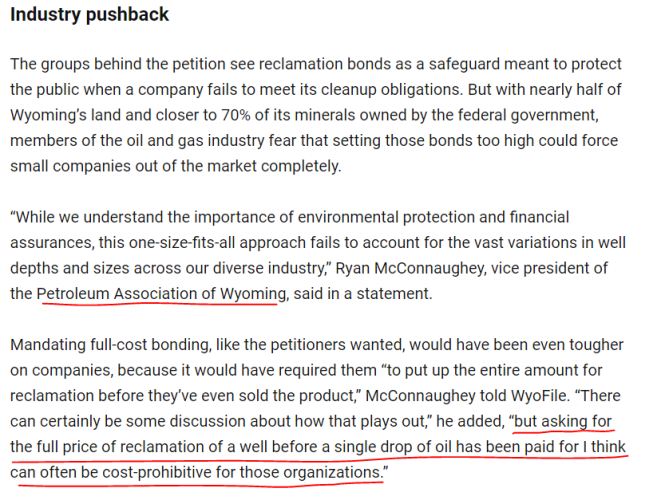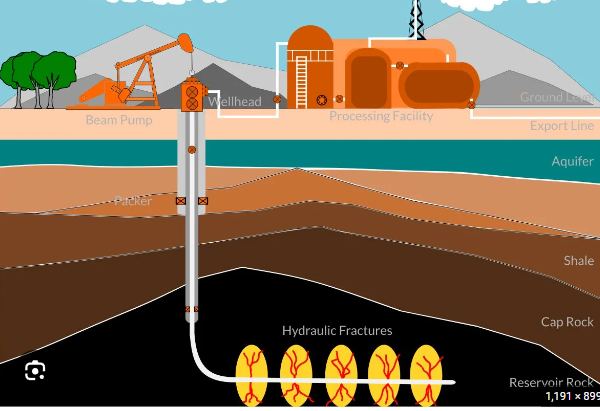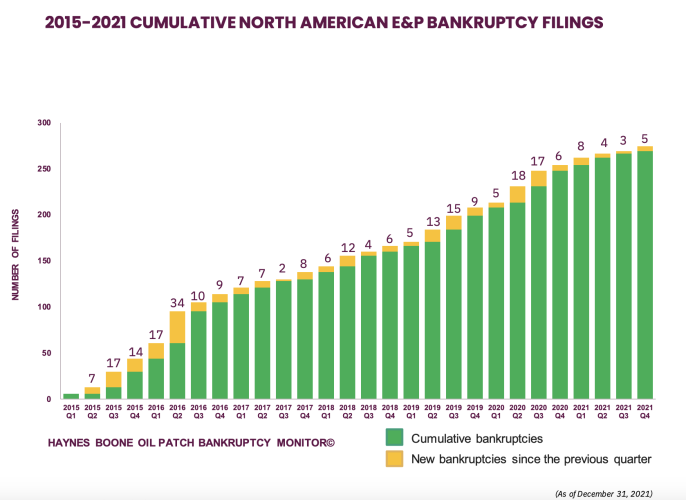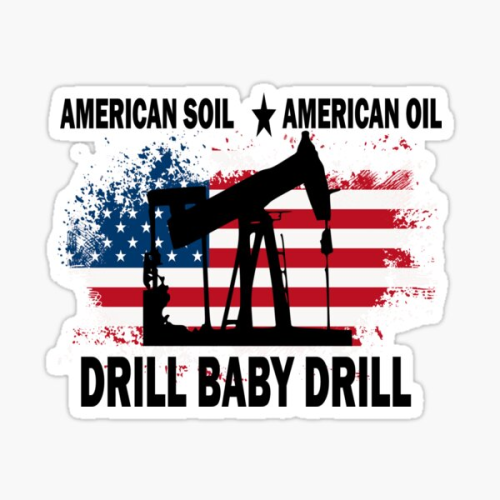Not related to the specific topic, but I'll discharge these two WyoFile stories from the last three days here. Creeks tainted by drilling unable to sustain aquatic life, regulators say, but the operator of the Moneta Divide gas and oilfield says baloney.
Navigation
Install the app
How to install the app on iOS
Follow along with the video below to see how to install our site as a web app on your home screen.
Note: This feature may not be available in some browsers.
More options
You are using an out of date browser. It may not display this or other websites correctly.
You should upgrade or use an alternative browser.
You should upgrade or use an alternative browser.
Abandoned oil wells
- Thread starter Bigjay73
- Start date
Irrelevant
Well-known member
and yet... that's still too much to ask for.Ridiculous. They should be bonded to cover the cost of decommissioning and reclamation. If it costs too much to bond it or clean it up, then no permit.

BLM proposes sweeping changes to oil and gas reclamation program - WyoFile
Federal minimum bonds began to stagnate in 1951. In a win for environmental groups, the Biden administration wants to hike some and do away with another.

D
Deleted member 28227
Guest
"Not related to the specific topic, but I'll discharge these two WyoFile stories from the last three days here. Creeks tainted by drilling unable to sustain aquatic life, regulators say, but the operator of the Moneta Divide gas and oilfield says baloney.
The other would be to employ the 15,000-foot-deep, high-volume Marlin well to send tainted water into the Madison aquifer and other deep geologic provinces.
The Madison is a source of drinking water in Wyoming, including in parts of the Bighorn Basin and Crook County. Wyoming’s Oil and Gas Conservation Commission authorized disposal in the Marlin well, located south of the energy field, agreeing that the underground reservoir of potable water there was too remote and small, among other reasons, to justify protection from contamination."
Um... bullshit no way folks in WY have 15,000ft TVD drinking water wells.
Last edited by a moderator:
Irrelevant
Well-known member
oh really? Then why do we even have abandoned well programs?It’s always interesting to me that these articles seem to gloss over the fact that every operator who has ever owned the well is responsible for the plugging liability, if the current operator is defunct it reverts to the prior. You’re never really “off the hook”.

Orphaned Wells | U.S. Department of the Interior
Millions of Americans across the country live within just one mile from an abandoned coal mine or an orphaned oil and gas well.

D
Deleted member 28227
Guest
For vertical wells... maybe loland yet... that's still too much to ask for.

BLM proposes sweeping changes to oil and gas reclamation program - WyoFile
Federal minimum bonds began to stagnate in 1951. In a win for environmental groups, the Biden administration wants to hike some and do away with another.wyofile.com
View attachment 319942
A modern Hz well costs 3MM+ to drill and complete an extra 100k isn't a big deal.
Don't shoot me, I'm just the messenger. Several of the larger communities and national parks in western South Dakota and Wyoming rely on water from the Madison aquifer. These include Rapid City, Spearfish, Hot Springs, and Wind Cave National Park in South Dakota and Gillette, Douglas, Sheridan, Buffalo, Devils Tower National Park, and the Wind River Indian Reservation in Wyoming."The Madison is a source of drinking water in Wyoming, including in parts of the Bighorn Basin and Crook County."
Um... bullshit no way folks in WY have 15,000ft TVD drinking water wells.
"The Madison is a source of drinking water in Wyoming, including in parts of the Bighorn Basin and Crook County."
Um... bullshit no way folks in WY have 15,000ft TVD drinking water wells.
"Based on WSEO records, approximately 48 wells with water rights in excess of 50 gpm have been drilled within the area around Ten Sleep and Hyattville since 1945, as shown on Plate E.1. Most of these wells were completed in either the Madison Aquifer or the Flathead Sandstone and are flowing artesian. Used for municipal purposes, the City of Worland wells, Husky No. 1 and Worland No. 3, have the largest ground water appropriation of any wells in the area at 5,000 and 6,660 gpm respectively. In combination with the other seven municipal and quasi-municipal wells in the area, approximately 13,800 gpm of water rights have been allocated for municipal use in the area shown on Plate E.1. The second largest use of ground water in the area is irrigation. This area contains eleven wells that are each permitted to produce more than 400 gpm, and yield a combined total of approximately 13,300 gpm."
Irrelevant
Well-known member
um... Have you actually looking into the Gillette water project? Massive crazy project. Also the Madison isn't that deep in NE Wyoming."The Madison is a source of drinking water in Wyoming, including in parts of the Bighorn Basin and Crook County."
Um... bullshit no way folks in WY have 15,000ft TVD drinking water wells.

Did a huge Gillette water project frack-up rural wells? - WyoFile
Crook County residents suspect state-funded project that used “acid fracking” has polluted their water supply.
D
Deleted member 28227
Guest
Not a rhetorical question, but what happens when all prior operators are defunct? Do wells sit and languish the way old mining sites do?
Yes, definitely.
oh really? Then why do we even have abandoned well programs?
View attachment 319944
Orphaned Wells | U.S. Department of the Interior
Millions of Americans across the country live within just one mile from an abandoned coal mine or an orphaned oil and gas well.www.doi.gov
Wildcaters, flybynight operators, and/or super old wells.
My point is these are EOG, Exxon, or even Standard Oil wells.
D
Deleted member 28227
Guest
um... Have you actually looking into the Gillette water project? Massive crazy project. Also the Madison isn't that deep in NE Wyoming.

Did a huge Gillette water project frack-up rural wells? - WyoFile
Crook County residents suspect state-funded project that used “acid fracking” has polluted their water supply.wyofile.com
Exactly, the author of that article doesn't understand the topic, clearly.

chrome-extension://efaidnbmnnnibpcajpcglclefindmkaj/https://media.sd.gov/danr/powertech/wmb/McKaskey_Thesis.2013.05.10.pdf
Water wells are typically very shallow, I think the deepest in the US is ~7600ft. The injection well they are talking about is injecting at 15,000, so 2+ miles below the aquifer.
D
Deleted member 28227
Guest
See edited quote."Based on WSEO records, approximately 48 wells with water rights in excess of 50 gpm have been drilled within the area around Ten Sleep and Hyattville since 1945, as shown on Plate E.1. Most of these wells were completed in either the Madison Aquifer or the Flathead Sandstone and are flowing artesian. Used for municipal purposes, the City of Worland wells, Husky No. 1 and Worland No. 3, have the largest ground water appropriation of any wells in the area at 5,000 and 6,660 gpm respectively. In combination with the other seven municipal and quasi-municipal wells in the area, approximately 13,800 gpm of water rights have been allocated for municipal use in the area shown on Plate E.1. The second largest use of ground water in the area is irrigation. This area contains eleven wells that are each permitted to produce more than 400 gpm, and yield a combined total of approximately 13,300 gpm."
The injection well is waaaaaay below the water table. When you drill any well you run casing so that you specially don't have your well communicating with ground water.

See edited quote.
The injection well is waaaaaay below the water table. When you drill any well you run casing so that you specially don't have your well communicating with ground water.
View attachment 319950
you're talking to a guy with a geology degree that interned in O&G and worked for hydrogeo engineering consultants and later the state engineers office. i'm very aware of how it all works.
i'm just saying, it expressly said they were injecting into the madison and it seems the madison is indeed a confined aquifer which serves as a source for municipal high cap wells.
Last edited:
SAJ-99
Well-known member
Here is article that a lot of local stuff is spinning off of. It all gets fixed with money. The only question is who signs the check. My bet is on the US taxpayer..
I do love how it only took 18post for BHR to say "the real problem is solar".
The TLDR quote from the article...
"The practice is so tried-and-true that researchers and activists call it “the playbook.”"

 www.propublica.org
www.propublica.org
I do love how it only took 18post for BHR to say "the real problem is solar".
The TLDR quote from the article...
"The practice is so tried-and-true that researchers and activists call it “the playbook.”"

The Rising Cost of the Oil Industry’s Slow Death
Unplugged oil and gas wells accelerate climate change, threaten public health and risk hitting taxpayers’ pocketbooks. ProPublica and Capital & Main found that the money set aside to fix the problem falls woefully short of the impending cost.
D
Deleted member 28227
Guest
I know you do... was just taking the folks along for the ride. Also more my point the author doesn't understand, they aren't injecting "into" they are "drilling through the" and the author doesn't understand the difference.you're talking to a guy with a geology degree that interned in O&G and worked for hydrogeo engineering consultants and later the state engineers office. i'm very aware of how it all works.
i'm just saying, it expressly said they were injecting into the madison and it seems the madison is indeed a confined aquifer which serves as a source for municipal high cap wells.
I know you do... was just taking the folks along for the ride. Also more my point the author doesn't understand, they aren't injecting "into" they are "drilling through the" and the author doesn't understand the difference.
also my fault for not really reading into anything beyond the snippets posted in yours or others posts.
D
Deleted member 28227
Guest
"The practice is so tried-and-true that researchers and activists call it “the playbook.”"

The Rising Cost of the Oil Industry’s Slow Death
Unplugged oil and gas wells accelerate climate change, threaten public health and risk hitting taxpayers’ pocketbooks. ProPublica and Capital & Main found that the money set aside to fix the problem falls woefully short of the impending cost.www.propublica.org
That's definitely a very cynical and inaccurate statement by the author.
Here is the real process.
When you start a company you assemble a lease position, some of this comes from knocking on doors and taking new leases, some comes from buying old leases. These leases are HBP, held by production, meaning they have a working well on them, usually an old vertical.
You put together drilling units 640 acres, 1280acres are the most common for your Hz wells, some companies still drill verticals but in shale plays today it's less common.
Once your new well is drilled, that well holds the leases. If the original well was in the same formation as your new well and/or was close to the bore path you likely killed the well when you fracked.
These well are then plugged and remediated.
You also have old wells that just chug along in shallow formations, they don't cost much to operate and make money so you leave them.
There are also companies that specialize in buying old wells either plugging them or recompleting them to increase production. If you have a ton of wells that aren't needed to hold acreage you might sell to that kind of company, they know that a lot of the wells are going to be plugged so that's baked into the purchase price. Your good verticals might be worth 20MM the plugging liability on the bad ones is 500k so they buy it for 18MM, you take the haircut to get them off your hands. The plugging company because of scale is able to plug them for 300k and makes money there as well.
Hillcorp is definitely in that part of the business which is why I rolled my eyes when folks got excited about them buying BP Alaska.
SAJ-99
Well-known member
Sure, but there is a business in briefly extending the life of old wells in an undercapitalized company that will eventually go bankrupt and leave the taxpayer on the hook. Then the executives move to another company and rinse and repeat. Even for those "young" enough to post a remediation bond, the amount isn't enough to cover the bill. I'm not blaming them. It was all done with government approval because people want cheap fuel. However, at some point the bill comes due.That's definitely a very cynical and inaccurate statement by the author.
Here is the real process.
When you start a company you assemble a lease position, some of this comes from knocking on doors and taking new leases, some comes from buying old leases. These leases are HBP, held by production, meaning they have a working well on them, usually an old vertical.
You put together drilling units 640 acres, 1280acres are the most common for your Hz wells, some companies still drill verticals but in shale plays today it's less common.
Once your new well is drilled, that well holds the leases. If the original well was in the same formation as your new well and/or was close to the bore path you likely killed the well when you fracked.
These well are then plugged and remediated.
You also have old wells that just chug along in shallow formations, they don't cost much to operate and make money so you leave them.
There are also companies that specialize in buying old wells either plugging them or recompleting them to increase production. If you have a ton of wells that aren't needed to hold acreage you might sell to that kind of company, they know that a lot of the wells are going to be plugged so that's baked into the purchase price. Your good verticals might be worth 20MM the plugging liability on the bad ones is 500k so they buy it for 18MM, you take the haircut to get them off your hands. The plugging company because of scale is able to plug them for 300k and makes money there as well.
Hillcorp is definitely in that part of the business which is why I rolled my eyes when folks got excited about them buying BP Alaska.

D
Deleted member 28227
Guest
Sure, but there is a business in briefly extending the life of old wells in an undercapitalized company that will eventually go bankrupt and leave the taxpayer on the hook. Then the executives move to another company and rinse and repeat. Even for those "young" enough to post a remediation bond, the amount isn't enough to cover the bill. I'm not blaming them. It was all done with government approval because people want cheap fuel. However, at some point the bill comes due.
I mean most companies just don't drill good wells, spend too much on those wells, buy their acreage for too much, etc etc.
I'm skeptical it's a business model rather than a effective of a drill baby drill attitude with poor fundamentals.
TwistedSage
Well-known member
I have a quail spot that is a large chunk of abandoned wells on mostly state and some blm land. Some of the biggest mesquites are in the crevasses around the pads. It kind if feels like hunting in some post apocalyptic landscape
Similar threads
- Replies
- 3
- Views
- 254
- Replies
- 139
- Views
- 7K





